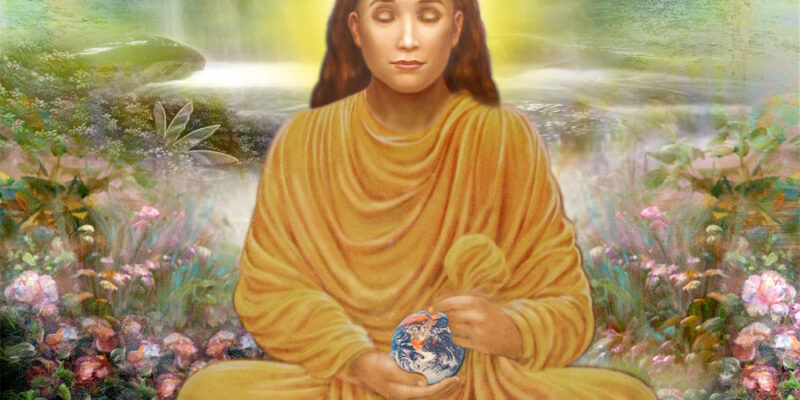Mahavatar Babaji - Founder of Kriya Yoga Sadhguru in his book "Death - An inside story" explains how Mahavatar Babaji…
Gauri Shankar Peetam

Babaji’s mission includes helping humanity to gradually realise God, and through the resulting Universal Vision of Love, a transformation of this world into a Divine paradise. Babaji’s mission continues to manifest itself through the work of all who turn to him as their source of inspiration, as well as through all who express pure love in thought, word or deed. Where there is love there is Babaji. By learning to communicate with Babaji anyone can bring about a transformation in their life and circle of influence, and resolve the myriad problems facing humanity in many domains. The great vehicles of Babaji’s mission are sadhana (the five fold path of Kriya Yoga described in chapter 12), self surrender and service. Without surrendering the ego consciousness, there is no room for the Universal Vision of Love to manifest itself. Selfless service, without attachment to the fruits or results of the action, help to free one from the illusion of being the door, wherein the ego foots cut off from the Divine. Those who aspire to serve Babaji and his Divine mission, can best do so by committing themselves to these three means of transformation. In Babaji’s Kriya Yoga, the benefits of it flow, in part, automatically to those who seek assistance from the Kriya Yoga practitioner. One becomes a transmission station, figuratively speaking, relaying the inspiration and Love from that Himalayan broadcasting station in Gauri Shankar Peetam, into every sphere of activity.
Babaji’s Ashram: Gauri Shankar Peetam
Babaji’s ashram near Badrinath in the Himalayas is known as Gauri Shankar Peetam. It has been described by V.T. Neelakantan (Ramaiah, May 1954, pg. 3-10). According to him, he was allowed to make an astral visit to it twice in the last half of October, 1953. Neelakantan suddenly found that he had left behind his physical body in Madras, India, and had taken on another body standing with Babaji in Gauri Shankar Peetam. His description of the ashram and its activities are given below.
The ashram is situated near the temple town of Badrinath in an area surrounded by sheer rock cliffs on all four sides with a row of caves at their base. The largest cave belongs to Babaji. In a corner opposite this cave are two waterfalls. The residents of the ashram, who numbered fourteen, at the time of his visit, use the largest waterfall for bathing and the smaller one for getting drinking water. The water from these waterfalls forms two streams which come together at the opposite end of the area and then escapes through a tunnel like opening. Even at night, though there is no visible light source, the whole area is well lit. A mysterious force keeps any one from approaching the ashram closer than a mile. As a result, no one can reach the ashram without Babaji’s permission.
The residents were sitting in a circle, according to the account, in front of Babaji’s cave, eating a meal. Their clothing was white in color, with the exception of Babaji, whose dhoti (waistcloth) was in a light red color. During lunch, they spoke in Hindi and English with one another. Their faces were radiant and expressed great joy and happiness.
The residents included the sister (paternal cousin) of Babaji, “Mataji Nagalakshmi Deviyar” (also known as “Annai”). She was wearing a cotton sari, white in color, with a green border and a long red sash over it and around her neck. According to him, she is a strikingly beautiful woman, with fair skin, a thin frame and is taller than her brother. Her face is rather long with high cheek bones, and resembles that of Kashi, Paramahansa Yogananda’s disciple from the front, and that of Neelakantan’s own wife from the side.
Annai Nagalakshmi Deviyar is in charge of organizing the ashram and serves the residents in various capacities. She supervises the preparation of a daily, simple, vegetarian meal served at noon. The meal is supportive of the yogic lifestyle of the ashram. She takes special care of a largo “tulasi” plant which sits atop a “pootam”, or shrine, nearly four feet high. She daily worships “Tulasi Devi”, a great devotee of Lord Krishna. Tulasi Devi was granted a boon by the Lord to remain in His presence eternally as a sacred Tulasi plant in his celestial abode.
Annai’s favorite means of worship, is to worship the feet of her Lord, Babaji, in a ceremony known as “Pada Poosai”. “Pada” means “feet” and “poosai” means to worship with flowers[8]. During this ceremony, she lovingly places the feet of Babaji on a silver plate, washes and anoints them with sesame oil, mung bean powder, milk and other fragrances or precious articles. She then adorns his feet with “vibhuti” (ash from the mantra yagna fire), “kumkuma” (a red powder from the vermilion flower), and a number of other flowers growing in the ashram.
The other residents included several men with long flowing beards extending to their navel. A former Muslim ruler, after having offered all his army and wealth, which was refused by the Master, offered himself and was accepted as a disciple. A heavy sot Western lady and a girl, about ten years of age, and Swami Pranabananda, “the saint with two bodies” were also there.
He is now known as “Amman Pranabananda”, and physically resembles very closely the body of his last incarnation, except that he has allowed his hair and beard to grow long. Swami Pranabananda has been described by Yogananda (Yogananda, 1969, pg. 22-28, 260, 350). Swami Pranabananda, at the end of his previous incarnation, had made a conscious exit from his physical body, known as “mahasamadhi”, before his assembled disciples. Some years later he was reborn. As a young man, he suddenly remembered his previous life and connection with Babaji. He then went to the Himalayas in search of his deathless guru. Finally, through the grace of Babaji, he was reunited. After practicing Kriya Yoga intensively under the guidance of Babaji for a number of years, he attained the deathless state of soruba samadhi. He is reverentially now known as “Dadaji” or “Amman Pranabananda”. He now serves as a source of spiritual inspiration and guidance for many students. He also supervises the care of the ashram garden.
Among the disciples of Babaji, only Amman and Annai have attained the deathless state of sourabha samadhi. Their attainment, more than anything, reflects the completeness of their self surrender to God, the highest goal of Kriya Yoga. Having overcome the limitations of the ego-consciousness, they now assist all who seek their aid. Annai, in particular, assists Kriya Yoga sadhakas during the midnight meditation hour to completely cleanse the subconscious mind using the first meditation technique taught during the initiation into Kriya Dhyana Yoga. Amman Pranabananda, as a master of the fourth meditation technique, assists the Kriya Yoga sadhakas to tap their great potential for intellectual inspiration.
Many saints and sages have realized God in the spiritual and mental planes. However, very few have been able to bring about a complete surrender to the Divine consciousness at the level of vital plane and the cells of the physical body, so subject are they to the forces of disease, aging and death. These remain the last bastion of the limiting ego and subconscious. For all Kriya Yoga sadhakas (initiated students of Kriya Yoga) and devotees, Babaji, Annai and Amman serve as great examples of self surrender. They are virtually living embodiments of the Divinity.
The residents of the ashram adhere to a daily schedule centered around the practice of yogic sadhana, which includes asanas, pranayama, meditation, mantras and bhakti yoga. According to V.T. Neelakantan, everyone awakens at four in the morning. After taking a bath by the large waterfall, there is then an hour of yogic sadhana with emphasis on pranayama. In the afternoon, the residents follow their individual respective sadhanas with occasional consultation with Babaji on the practice of the techniques.
Babaji’s loving personality, his warm sense of humor and universal compassion endear him to all. If one had to choose one word which would best describe him, it would be “humility”.
According to other eyewitness accounts, in the evening the residents sit in a circle and chant around a large “Homa” fire in front of Babaji’s cave. The favorite chant is “Om Kriya Babaji Nama Aum”. “Om” and “Aum” mean the sound of the universe respectively experienced externally and internally. “Nama” derived from “Namaha” means “salutation”. It is sung according to a variety of melodies and rhythms. During Guru Purnima celebrations in early July, flowers are offered to the feet of Babaji by all of the residents. The ashram’s “Mother”, Annai Nagalakshmi, is worshipped by all with great reverence, as the embodiment of the Divine Mother, the Cosmic Shakti.
In discourses Babaji has spoken of Himself as being Absolute Existence, Truth and Bliss. He has referred to Himself as the Impersonal Personality of the universe, the all in one and the one in all, the immortal, infinite and eternal Self. One should learn Kriya Dhyana Yoga (meditation) to fully experience his divine personality.
Kriya Yoga sadhakas should understand that the “heaven on earth”, Gauri Shankar Peetam exists not only in the Himalayas, but also within the hearts of Babaji’s devotees. His physical ashram remains inaccessible because Babaji prefers to work silently and anonymously in the world, helping thousands of devotees and millions of souls to evolve at their own pace. Like a great broadcasting station he beams out His message of Universal Love and Peace to all.



